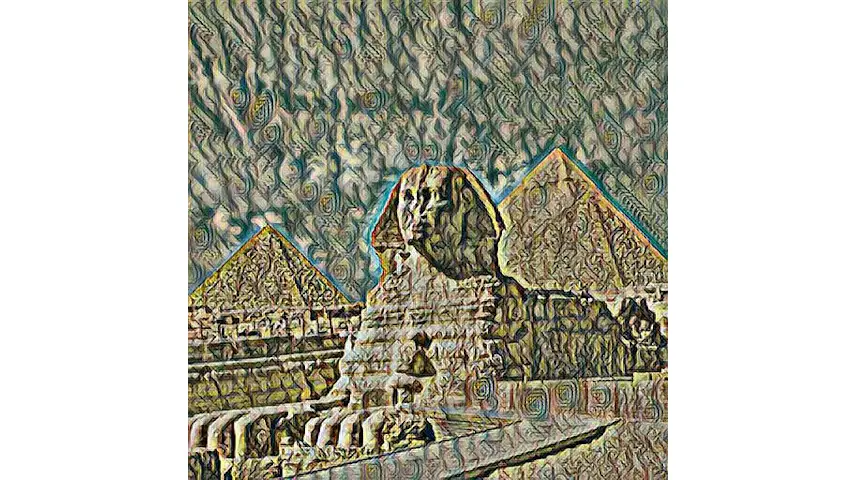Understanding Jackson Pollock’s painting technique is crucial for using his style in your artwork or style transfers. I poured through all of Pollock’s paintings to find the best secret drips of style and technique.
As a general rule, Jackson Pollock painted using a technique he pioneered called Drip painting. Instead of using a traditional brush or pallet knife, Pollock would splatter drops of paint on the canvas, or pour the paint directly from a can using a stick.
This painting method sounds simple on paper, but it takes lots of discipline and control to get right. Pollock once said, ‘I can control the flow of paint; there is no accident’. To understand his style, we need to dig into the details.
Introducing Jackson Pollock
Table of Contents
Born in 1912, Jackson Pollock is widely recognized as one of the most influential artists of his generation. Considered one of “The Big Five” alongside Willem de Kooning, Robert Motherwell, Mark Rothko, and Clyfford Still, his abstract expressionist paintings have become some of America’s most iconic artworks.
He was a member of New York’s avant-garde ‘abstract expressionist’ movement – known for breaking away from realism in painting – there was much more to his style than simply rejecting traditional methods.
I can control the flow of paint; there is no accident
Jackson Pollock [1]
Using brushes and sticks, he would then comb through the canvases to create different effects. In doing so, Pollock pioneered not only a new method of creating artworks but also changed what viewers thought was possible for artists in future generations.
The canvas played a crucial role in the creative process, so it is important to examine the types of canvas Pollock used.



Did Pollock Use Unprimed or Stretched Canvas?
Some aspects of the painting canvas affected Pollock’s style. Primed canvas has primer applied before any painting which allows the paint to stick to the material easier. Stretched canvas is a canvas that has been stretched and stapled to a frame for display.
As a whole, Jackson Pollock’s paintings were made on canvas that was not stretched and could be either unprimed or primed. Pollock rolled the canvas in the style of a rolled carpet. His Drip technique required him to rearrange the canvas frequently while painting and it could not be stretched.
With Pollock placing his paint so precisely, concepts like lines and patterns take on new meaning. Canvas control and texture become prime factors in how the artwork is produced.
Many artists say they prefer unprimed canvas because it allows for more movement during the initial painting. If you prime your canvas first, it makes those adjustments much more difficult down the road while painting.
| Name | Paul Jackson Pollock |
| Date of Birth | 28 January, 1912 |
| Date of Death | 11 August, 1956 |
| Location | Spring, New York, United States |
| Movements | Abstract Expressionism |
| Artistic Focus | Paintings |
| Favorite Medium | Alkyd Enamels (Resin-Based Paint) on Canvas |
Painting with the canvas stretched on a frame was one of the conventions Pollock loved to defy. It’s important to look at some of the others and how Pollock’s rebellion against convention affected his style.
What is Convergence?
Non-abstract paintings often follow conventions or unwritten rules about what makes a painting good. One of these conventions is called convergence and affects where the viewer’s eyes are drawn to when looking at an artwork.
Convergence is a technique in art used to focus the viewer towards some object or element depicted in the artwork. This can be accomplished by the artist using lines, colors, or patterns that converge at a focal point within the painting, drawing, or piece of art.
Since Pollock was an Abstract Expressionist, he didn’t often obey artistic conventions like this. On the contrary, he actively rebelled against rules. Why is one of his most famous paintings titled Convergence?
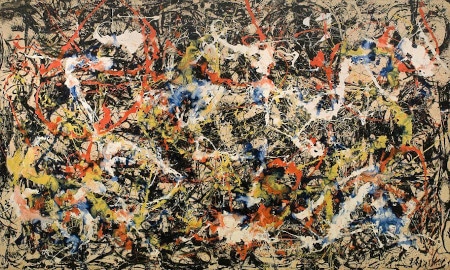
The Difference Between Convergence and Pollock’s Convergence
The painting titled Convergence was created during Pollock’s ‘black period’ where he experimented with using only black and white in his paintings. Convergence is full of color just like his earlier paintings.
The painting Convergence by Jackson Pollock originally started as a black and white painting. Believing the painting to be a failure, Pollock added color in an attempt to salvage it. The painting is a ‘convergence’ of two paintings, the earlier black and white version, and the new colorful version.
It could be argued that Pollock also uses artistic convergence within the painting and draws the viewer’s attention using colorful tones among the black and white. The painting today is considered one of his masterpieces. How did Pollock create other masterful artworks?
| # | PAINTING NAME | YEAR PAINTED | LOCATION |
|---|---|---|---|
| 1 | Number 5 | 1948 | Private Collection, New York, United States |
| 2 | Blue Poles (Number 11) | 1952 | National Gallery of Australia, Canberra, Australia |
| 3 | One: Number 31 | 1950 | Museum of Modern Art, New York, United States |
| 4 | Number 1 (Lavander Mist) | 1950 | National Gallery of Art, Washington DC, United States |
| 5 | Convergence | 1952 | Albright-Knox Art Gallery, Buffalo, New York, United States |
| 6 | Mural | 1943 | Stanley Museum of Art, Iowa City, Iowa, United States |
| 7 | Number 30 (Autumn Rhythm) | 1950 | Metropolitan Museum of Art, New York, United States |
| 8 | The She Wolf | 1943 | Museum of Modern Art, New York, United States |
| 9 | The Deep | 1953 | Centre Georges Pompidou, Paris, France |
| 10 | Full Fathom Five | 1947 | Museum of Modern Art, New York, United States |
How did Pollock Create The Deep?
The Deep is one of the paintings from Pollock’s ‘black period’. It uses mostly black, white, and gray with small hints of yellow mixed in. Since it was created late in his life, it was painted when Pollock’s techniques were the most refined.
As a general rule, Jackson Pollock used a technique called Action Painting to paint The Deep and other masterpieces. He would often stand over the canvas or dance around it. At the same time, he would drip or pour paint from above. Action Painting allows the paint to move in a fluid motion.
Pollock incorporated dance as an integral part of his process, making it much more than an afterthought. This process has inspired many other artists and allows for spontaneity in the creation process.
I believe easel painting to be a dying form, and the tendency of modern feeling is toward the wall picture or mural.
Jackson Pollock [2]
When making a painting, it is important to take into account these different characteristics to create something aesthetically pleasing. Painting style may not seem like an important factor when creating an artwork, but style is very vital to give an image form and shape.
In his essay, “What Makes Something Art?” Arthur Danto claims that we often mistakenly describe some art as non-art because we fail to see it as art, despite its adherence to what he calls our artist’s aesthetic. [3]
Understanding Pollock’s style will help any artist create a successful piece by using appropriate texture and colors while staying true to his artistic vision. With such chaotic creations, why do people like his artwork?
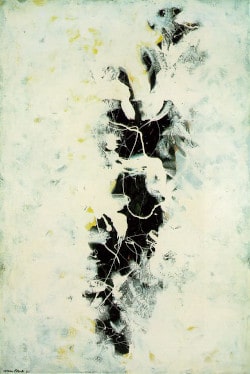
Why Do People Like Jackson Pollock Paintings?
One of the best Abstract Expressionist painters from America, Jackson Pollock was able to do things that were so out of the box that I have to just look on in wonder. He was famous for his unique style of using drips and movements to form paintings.
One of his most famous pieces is called Mural on Indian Red Ground (1943). However, what many are interested in today is not just how it looks but also how he made it – Pollock’s Action Painting was a masterwork in creating art without using brushes or other conventional painting instruments!
Pollock’s artwork has been shown to exhibit fractal patterns which are similar to natural shapes and are pleasing to the eye. [4] Using a fractal analysis is one of the methods for detecting if a painting is a true Pollock. [5]
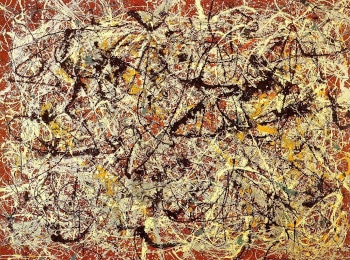
Artists Can Learn From Studying Pollock
Studying how one of America’s most influential artists, a creator of abstract expressionism, worked can teach us a lot about style. For example, he would work on several canvases at once and focus on laying down his background colors before moving on to working with other colors.
He also relied heavily on splattering paint directly onto his canvases. This style gave his work a sort of texture that is instantly recognizable to anyone familiar with art history, even without understanding what abstract expressionism is.

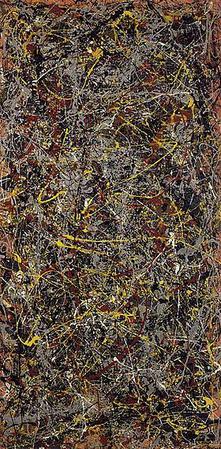

Although he often had specific patterns and designs in mind, he would let some shapes and colors develop organically as well, often starting with a mistake that turned out to be beneficial or interesting in its own right.
This can have an important effect when you’re approaching your work. It can be easy to fall into habits or default methods of painting (or design). By studying Pollock’s techniques, we can see how important it is to create new things through experimentation.
Create Your Own Jackson Pollock Style Painting
For those looking to recreate a Pollock-style painting, there are a few key considerations. Begin with choosing a medium. Artists can choose from oil paint, watercolor, and acrylic paints. [6]
All three materials have different properties that affect how they will react with an artist’s brush or drip device. For example, oils are opaque and can make the paint appear darker than it is, while watercolors create transparent layers on top of one another when applied on wet paper.
The three paint choices are as follows:
- Oil paints take longer to dry than watercolors, they are very durable when properly applied and offer a large range of colors.
- Watercolors dry faster than oils, can be used on absorbent or non-absorbent surfaces like paper or fabric, and offer an unlimited range of colors that appear translucent when applied over a wet paper.
- Acrylic paints resemble liquid acrylics that harden when exposed to air; they provide quick coverage with less layering required compared to watercolor paints. They can be applied to wet or dry surfaces and are more durable than oils, making them a good choice for outdoor artwork, projects in public spaces, and outdoor signs where the weather is a concern.
There are also two major types of canvas to choose from, cotton duck and linen canvases. Let’s break down the different canvas choices:
- Cotton duck is lightweight, smooth-textured, but difficult to stretch well because it tends to shrink once stretched.
- Linen canvases hold tension better and include a slight texture due to their weave pattern, making them a popular choice for artists seeking a more rustic appearance in their work.
After choosing your medium and canvas, it’s time to mix colors. Artists should consider using two complementary colors: colors that sit opposite each other on an artist’s color wheel, to create a complementary or split-complementary palette.
It [She Wolf] came into existence because I had to paint it. Any attempt on my part to say something about it, to attempt explanation of the inexplicable, could only destroy it.
Jackson Pollock [7]
Red and green are two complementary colors that will work; while these two colors appear similar in hue they create an energizing visual contrast once used together on a painting or canvas. Split-complementary pairs include yellow-orange paired with blue-violet or orange paired with violet or blue mixed with yellow.
Examples of these color schemes can be seen in Pollock’s works like She Wolf, The Mural, Convergence, or Number 5. [8]
Once you’ve chosen your paint colors, mixing them is important to make sure you achieve hues that are slightly lighter than what you started with. This step allows artists to achieve muted tones without muddying their work due to excess paint on their brush or dripping across their canvas.
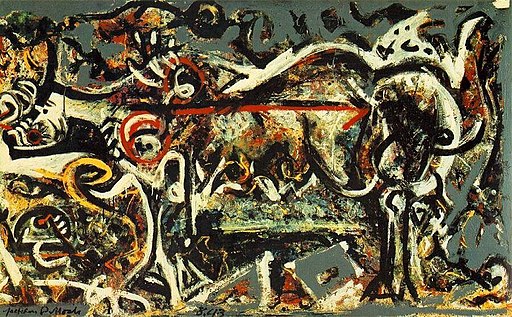
Drip devices can be simple plastic bottles filled with liquid acrylics which should be applied gently onto a wet surface so that pools form at regular intervals rather than randomly throughout a work of art. A cheaper alternative can be created by taping several paper cups together around a hose attachment fitted onto an air compressor connected to your plastic bottle filled with acrylic paints.
The canvas or support material should be placed on a sturdy base like wood or metal, then clamped down. This will keep your canvas from moving as you apply pressure from either side and make sure that each layer dries before applying another one for the best results and color quality.
Style transfers are a new form of digital art using neural networks. Interested in learning more? Check out the post on Style Transfers, Neural Networks, and Digital Art!


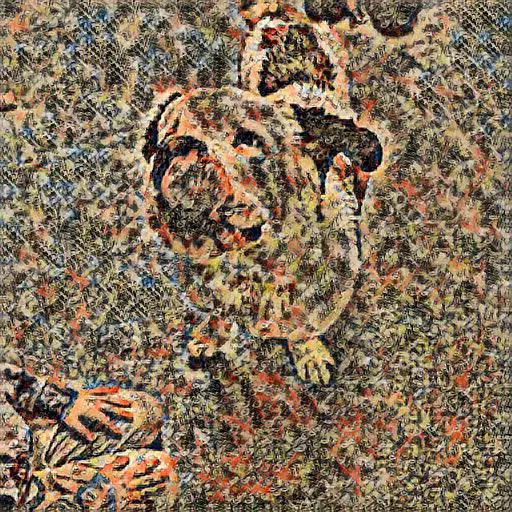
As is evident, there are many steps involved in replicating Jackson Pollock’s drip style of painting, even when it is replicated using a computer. [9] However, keeping these tips in mind can help artists achieve their unique style over time. At its heart, art is not only an expression of one’s soul but also reflects one’s desire to create and express new ideas through familiar mediums, all while experimenting and challenging oneself along the way!
Looking for inspiration from other styles for your own artwork and style transfers?
- Express your creative side by checking out the Van Gogh Style Guide
- Get an impression of Monet’s masterpieces in the Monet Style Guide
- Peek at the masterpieces in the Picasso Style Guide
- Take a Rothko Retrospective with the Mark Rothko Style Guide
- Journey through the symbolic depths with Frida Kahlo’s Style Guide
- Discover Dali’s surreal style with the Salvador Dali Style Guide
Want to learn more about how style transfers and neural networks work?
- Don’t lose out on my article about what content loss is!
- Want to know about Dropout and whether you should use it in your own networks? Check out my post on if you should always use Dropout.
- Want to learn more about the influential VGG network? Check out my post covering why VGG is so common!
- Improve your training data using Data Augmentation techniques!
Convergence of Final Thoughts
You should have a great idea of Jackson Pollock’s style for your work and style transfers. This post covered the details drip-by-drip. If you want to check out other styles, see some of the Style Guides in the Style Transfers category.
The most common method of style transfers is using neural networks. All the transfers in this post were using this method! Want to learn more about neural networks in python? Check out my tutorial about implementing Bayesian Neural Networks using the most popular python libraries.
Get Notified When We Publish Similar Articles
References
- Engelmann, Ines. Jackson Pollock and Lee Krasner. Prestel Pub, 2007. https://www.goodreads.com/book/show/1606549.Jackson_Pollock_and_Lee_Krasner
- Hess, Barbara, and Uta Grosenick. Abstract expressionism. Taschen Köln, 2006. https://www.goodreads.com/book/show/13297.Abstract_Expressionism
- “Arthur Danto.” Wikipedia, Wikimedia Foundation, 15 Mar. 2022, https://en.wikipedia.org/wiki/Arthur_Danto#%22Artworld%22_and_the_definition_of_art
- Taylor, Richard P., Adam P. Micolich, and David Jonas. “Fractal analysis of Pollock’s drip paintings.” Nature 399.6735 (1999): 422-422. https://www.nature.com/articles/20833.pdf
- Shamir, Lior. “What makes a Pollock Pollock: a machine vision approach.” International Journal of Arts and Technology 8.1 (2015): 1-10. https://citeseerx.ist.psu.edu/viewdoc/download?doi=10.1.1.647.365&rep=rep1&type=pdf
- Lake, Susan, Eugena Ordonez, and Michael Schilling. “A technical investigation of paints used by Jackson Pollock in his drip or poured paintings.” Studies in Conservation 49.sup2 (2004): 137-141. https://www.tandfonline.com/doi/abs/10.1179/sic.2004.49.s2.030
- Anfam, David. Abstract expressionism. Vol. 130. London: Thames and Hudson, 1990. https://thamesandhudson.com/abstract-expressionism-9780500204276
- Mureika, Jonas R. “Fractal dimensions in perceptual color space: a comparison study using Jackson Pollock’s art.” Chaos: An Interdisciplinary Journal of Nonlinear Science 15.4 (2005): 043702. https://arxiv.org/pdf/physics/0509152.pdf
- Zheng, Yan, et al. “Layered modeling and generation of Pollock’s drip style.” The Visual Computer 31.5 (2015): 589-600. https://personal.utdallas.edu/~KZhang/Publications/VisComp2014.pdf

